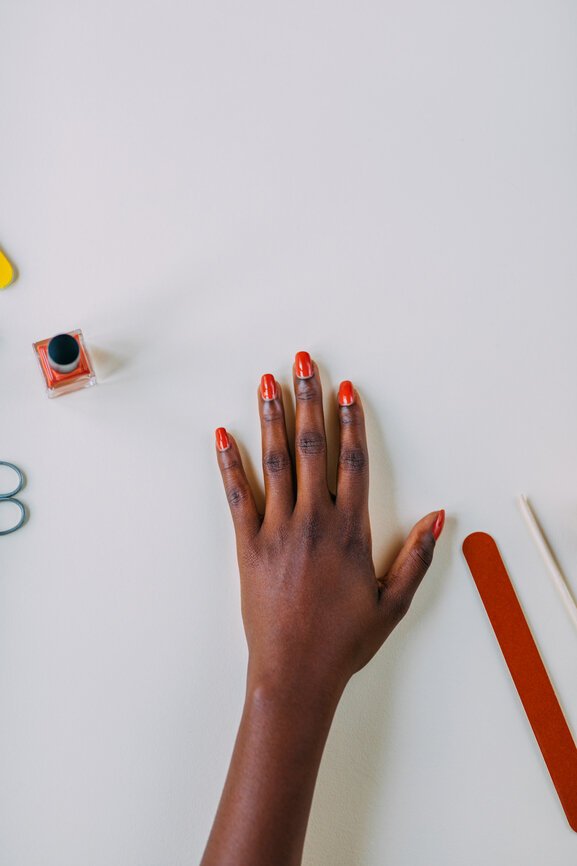
How To Give Yourself A Nontoxic At-Home Manicure
My Salon-Free Nail Routine 💅
Going to a nail salon is one of my favorite self-care practices—I love when my nails look polished (pun intended). But, finding a salon that uses natural products isn’t always easy, and as it’s safer to stay at home right now, I’ve been learning the art of an at-home manicure.
Even though it may feel intimidating, taking care of your nails can be a meditative practice once you have the right tools. It can pair well with a calming beverage and a movie playing in the background. The key is to take your time and acquire the right tools—which can save you money in the long run.
If doing nails at home is new for you, this will be the perfect guide to incorporate nail care into your routine as a self-care ritual. If you already love doing your nails at-home, but you’re looking to transition to nontoxic products, you’re in the right place, too!
“Remember, nontoxic doesn’t have to mean non-fun—you can still get creative with colors and designs.”
This guide will show you how to create a nontoxic nail bag, as well as offer my favorite tips for a professional-looking, nontoxic manicure. Remember, nontoxic doesn’t have to mean non-fun—you can still get creative with colors and designs. And thankfully, many brands are manufacturing cleaner alternatives that can help us achieve a salon-quality mani-pedi that’s both clean and affordable! Here’s how to get started.
Creating Your Zero Waste Manicure Kit
When creating a zero waste manicure bag, remember that it will take time. Don’t throw away the nail products you currently have that aren’t considered nontoxic. Slowly integrate cleaner products into your manicure kit as you run out. Then, when it’s safe to go to salons again, consider bringing your own products along or researching nontoxic nail salons in your area.
1. Nail brush, file, and clippers
Most nail files are emery boards, which are made from sandpaper, cardboard, and glue. Even though they can last a long time, they will eventually wear out and need to be thrown away. Because they can’t be properly sanitized, they are also prone to buildup and bacteria.
Instead, opt for nail files made from stone, metal, or glass—the latter is a favorite of nail enthusiasts. These options are also zero waste and can be regularly sanitized with warm water and nontoxic soap.
While truly sustainable nail clippers are hard to come by (and they aren’t always necessary for a manicure), it is nice to have them in your at-home kit. Try to purchase from a small business and invest in quality so that you can keep them for a lifetime. Lastly, I love a good nail brush for keeping my nails and skin clean.
Products we love:
-
Mischo Beauty Nail File | $10
-
Kiya Nail Clippers | $20
-
GRN Wood Nail Brush | $10
2. Cuticle scraper, pusher, and oil
One of the best parts about getting a professional manicure is the care your cuticles receive, especially if you’re a cuticle biter like me. 😬 There are many helpful videos on YouTube to learn proper cuticle care at home. This specific tutorial explains our nails’ anatomy and how to scrape away dead skin (gently).
While cuticle maintenance can be beneficial to nail care, some people may prefer not to push their cuticles at all—and that’s okay! Cuticle oil and strengthening masks also work great for natural and noninvasive care. Ideally, you can add cuticle oil to your nails post-polish and top coat!
Products we love:
-
Côte Nipper | $14
-
Côte Pusher | $8
3. Nail Polish Remover and Pads
Nail polish remover is one of the most toxic products found at your local drug store. It’s also tempting to use because it takes off nail polish so easily. However, the solvents (like acetone) found in nail polish remover aren’t good for our health. There is also a concern for manicurists and pregnant women who are more sensitive or often exposed to these chemicals. The good news is that many toxic-free nail polish removers still do the job and are excellent for nail health. These solutions contain moisturizing vitamins and oils instead of harsh, drying acetates.
When it comes to removing old polish, it’s easy to reach for cotton balls, toilet paper, or paper towels. But consider how the chemicals from the polish then go straight into the trash (not to mention the waste). Instead, try using a reusable cloth or fabric scraps. You can also invest in reusable nail polish pads that look cute and will last a long time.
Products we love:
-
786 Soy Polish Remover | $12.99
4. Nontoxic and Natural Nail Polish
We don’t often consider how our nails (or their color and texture) can tell us a lot about our health. But if we’re using nontoxic products on the rest of our bodies, why should our nails be an exception? Unfortunately, it hasn’t always been the most nontoxic or natural habit.
As with many products in the beauty industry, nail polishes and treatment products contain harmful chemicals. For instance, Toluene is a petrochemical or “lab-produced solvent” that’s often found in nail polishes and even in the air at nail salons.
According to a Public Health Statement put out by the Agency for Toxic Substances and Disease Registry, “It is produced in the process of making gasoline and other fuels from crude oil and in making coke from coal.” The clear and colorless liquid has been linked to both short- and long-term health problems, including headaches, kidney and liver damage, and even reproductive health. Moreover, it pollutes the environment.
Other than Toluene, there are additional toxins in nail polish, some of which are endocrine disruptors. They disrupt the complex hormone system by mimicking estrogen in your body. This can affect many aspects of the body, including the organs, reproductive system, and development in children. This is where chemical-free polishes come in. These are often branded as 3-, 5-, 7, or 10-free to note the harmful ingredients not included in the polish.
“Did you know many recycling centers can’t take used nail polish bottles because they are considered hazardous waste? Yikes.”
Another thing you’ll want to keep in mind is the nail polish packaging. Did you know many recycling centers can’t take used nail polish bottles because they are considered hazardous waste? Yikes. Use this search tool to check if your local center takes polish bottles or find your nearest Household Hazardous Waste facility. If they don’t, look for nontoxic brands hosting recycling programs like the LA-based brand Côte.
Alternatively, you can use nontoxic paint thinner to clean the bottles and then upcycle them into tiny vases for wildflowers or plant propagation.
See our favorite nontoxic nail polishes here.
How To Give Yourself a Nontoxic Manicure
Now that you have your clean and sustainable mani kit, here are some basic steps to achieving a salon-grade manicure:
Step 1: Clean and shape your nails
Remove old polish: Start by removing any old polish and cleaning your hands and nails with a nail brush. If you’re removing a darker color and want to avoid staining your skin, try coating the area around your nail with a thick moisturizer before applying any remover. This will keep the old polish from staining your skin or cuticles.
Prep your cuticles: If you’re using a cuticle pusher or scraper, now is the time to remove that dead skin from your nails! Again, I recommend following a tutorial for this and being gentle with yourself. You never want to cut your cuticles or cause them to bleed. Hold off on the cuticle oil for now.
Shape and file: A manicurist once told me that in order for your nails to be your desired shape, you should get in the habit of filing them the way you want them to grow. I started shaping my nails in an almond shape about eight years ago, and they now maintain this shape naturally as they grow. While I learned shaping techniques by going to the nail salon and watching the manicurists, you can also learn from online tutorials.
Even if you keep your nails short, you can still give them a smooth file with a slight shape. I recommend filing in one direction (instead of sawing back and forth) to create smooth edges and help prevent your nails from catching or breaking.
Step 2: Paint Your Nails
Prime your nails: One expert tip I love is to use a tiny dab of nail polisher remover to prime my unpolished nails before painting them. Because our nails and skin have oil build-up, this removes excess oil and creates a clean base to help the polish stick. I also recommend priming with a base coat.
Paint, Dry, Repeat: Time for polish! When it comes time to finally paint your nails, you may be eager to swipe on a thick glob of paint. But try to minimize the amount of polish you have on your brush for this first coat. Less is more, and you can fill in gaps after the first coat dries. (And let it fully dry!) Too much polish on the first pass makes it harder to stay in the lines, and you risk the paint pooling in your cuticles.
Finish with a top coat: After all that hard work, you’ll want to protect your manicure and make it shine! A top coat of polish is perfect for this. Another insider tip: Don’t forget the edge of your nails, either. You’ll want to “cap” your polish by painting a thin strip of topcoat on the edge. Not only will this prolong your manicure and keep the paint from chipping, but it will give your nails a professionally done look. You can also add cuticle oil to rehydrate your nails after polishing.
Step 3: Maintain your manicure and nail health
Finally, it’s all about maintaining your manicure once it’s finished. You can extend the life of your polish by adding a fresh layer of top coat every couple of days. And don’t be afraid to touch-up as needed. Manicures can be time-consuming, so it’s best when they last!
Are you new to at-home manicures, or are you a DIY devotee? Share your tips in the comments below! ✨
RELATED READING

Courtney Jay is a writer at The Good Trade. She is also a yoga instructor, health enthusiast, and sustainable fashion advocate. She believes the most powerful way to nurture the planet is to nurture ourselves. You can find more of her writing and take one of her online yoga classes on her website Coincide.